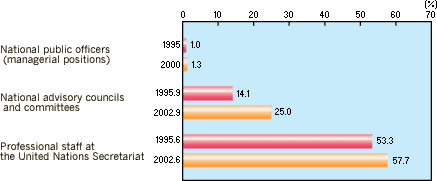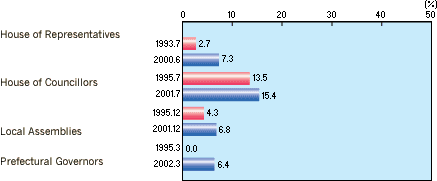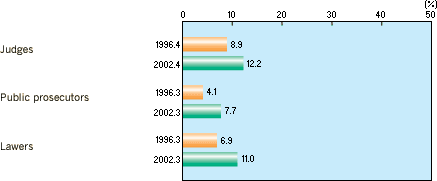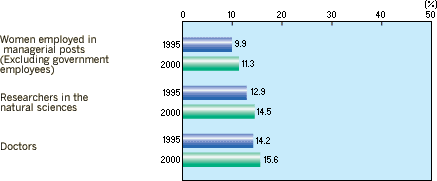![]()
Basic Data on Gender Equality in Japan
- Women's Participation in Various Fields
- Administration
The percentage of female national public officers in high-ranked managerial positions stood at 1.3% in fiscal 2000, and has shown a gradual increase over the long term.
According to a survey, as of September 30, 2002, the proportion of female members of national advisory councils and committees has risen substantially to 25%. Moreover, 97% of advisory councils and committees had female members, and twenty-five of them, 25% of the total number, had no less than 30%of female representation.
- International Fields
Eleven women have been appointed ambassador extraordinary and plenipotentiary since the first woman was appointed ambassador in 1980. Three of them currently serve as ambassador to Italy, Ghana, and the Disarmament Mission, and women comprise approximately 2.5% of all Japanese ambassadors (as of January 15, 2003). At the end of June 2001, women accounted for 57.3% of Japanese staff in the Secretariat of the United Nations.
The number of female Japanese professional staff in major international organizations including the United Nations has increased from 180 in 1994 to 333 in 2002. As of January 2003, Japanese women in senior level positions include the Deputy Executive Secretary of ESCAP, the Deputy Executive Secretary of UNIDO, and the Executive Secretary of the Secretariat of the Basel Convention.
WOMEN'S PARTICIPATION IN ADMINISTRATION
AND INTERNATIONAL FIELDS
(Sources)
National public officers, National Personnel Authority; National advisory councils and committees, Cabinet Office; Professional staff at the United Nations Secretariat, "omposition of the Secretariat" - Politics
With the exception of a short period after the war, the percentage of female members of the House of Representatives wavered between 1% and 2% until the thirty-eighth general elections in 1986, after which it began to rise. Female membership of the House of Councillor has risen gradually from 4% in the first ordinary elections in 1947. It rose sharply from 8.7% (in 1986) to 13.1% in the fifteenth ordinary elections in 1989, and has been rising ever since. Female representation in local assemblies is comparatively high, standing at 20% (as of the end of December 2001) in the assemblies of special wards (Tokyo), and 15% (as of the end of December 2001) in government-designated cities. Women accounted for 0.4% of city mayors, 0.2% of town mayors and 0.4% of village mayors as of the end of March 2001.
WOMEN'S PARTICIPATION IN POLITICS

(Sources)
House of Representatives, house of Councillor and local assemblies, Ministry of Public Management, Home Affairs, Posts and Telecommunications; Prefectural governors, Cabinet Office - Judiciary
The long-term trend is for the percentage of female judges, public prosecutors and lawyers to rise.
WOMEN'S PARTICIPATION IN THE JUDICIARY

(Sources)
Judges, Supreme Court; Public prosecutors, Ministry of Justice; Lawyers, Secretariat of the Japan Federation of Bar Associations - Managerial, Professional and Technical Fields
Although the percentage of women employed in managerial posts (excluding government employees), female researchers in the natural sciences and doctors remains low, their numbers have increased.
WOMEN'S PARTICIPATION IN MANAGERIAL,
PROFESSIONAL AND TECHNICAL FIELDS
(Sources)
Population Census of Japan. Ministry of Public Management, Home Affairs, Posts and Telecommunications
- Administration
